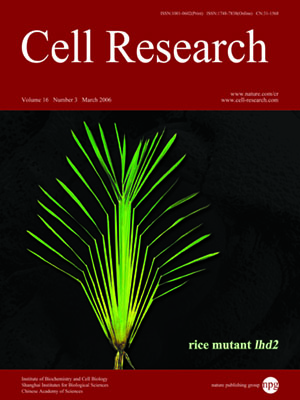
Volume 16, No 3, Mar 2006
ISSN: 1001-0602
EISSN: 1748-7838 2018
impact factor 17.848*
(Clarivate Analytics, 2019)
Volume 16 Issue 3, March 2006: 277-286
ORIGINAL ARTICLES
Expression and functional analysis of the rice plasma-membrane intrinsic protein gene family
Lei Guo1, Zi Yi Wang1, Hong Lin1, Wei Er Cui1, Jun Chen1, Meihua Liu1, Zhang Liang Chen1, 2, Li Jia Qu1, 2,
1Peking-Yale Joint Research Center for Plant Molecular Genetics and AgroBiotechnology, National Laboratory for Protein Engineering
and Plant Genetic Engineering, College of Life Sciences, Peking University, Beijing 100871, China; 2The National Plant Gene Research Center, Beijing 100101, China
Correspondence: Hong Ya Gu(guhy@pku.edu.cn )
Plasma membrane intrinsic proteins (PIPs) are a subfamily of aquaporins that enable fast and controlled translocation of water across the membrane. In this study, we systematically identified and cloned ten PIP genes from rice. Based on the similarity of the amino acid sequences they encoded, these rice PIP genes were classified into two groups and designated as OsPIP1-1 to OsPIP1-3 and OsPIP2-1 to OsPIP2-7 following the nomenclature of PIP genes in maize. Quantitative RT-PCR analysis identified three root-specific and one leaf-specific OsPIP genes. Furthermore, the expression profile of each OsPIP gene in response to salt, drought and ABA treatment was examined in detail. Analysis on transgenic plants over-expressing of either OsPIP1 (OsPIP1-1) or OsPIP2 (OsPIP2-2) in wild-type Arabidopsis, showed enhanced tolerance to salt (100 mM of NaCl) and drought (200 mM of mannitol), but not to salt treatment of higher concentration (150 mM of NaCl). Taken together, these data suggest a distinct role of each OsPIP gene in response to different stresses, and should add a new layer to the understanding of the physiological function of rice PIP genes.
Cell Research (2006) 16:277-286. doi:10.1038/sj.cr.7310035; published online 16 March 2006
FULL TEXT | PDF
Browse 1858


